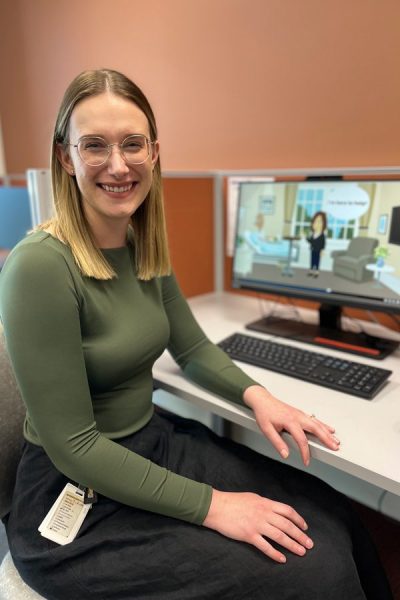Co-designed patient videos provide accessible nutrition information for patients

Hannah with one of the co-designed nutrition videos.
A patient care initiative led by STARS Dietitian Hannah Olufson is improving access to reliable nutrition information by creating patient information videos, thanks to funding from the RBWH Foundation.
The videos were co-designed, bringing together consumers, students and dietitians across the state.
“Local research and service evaluation activities identified several topics that were key nutritional concerns for patients. Patients and carers were looking for accessible and trustworthy nutrition information,” Hannah said.
“The co-design process supported consumers and dietitians to collaborate as equals to co-create nutrition information videos together, rather than waiting until the end of the resource development process to seek consumer feedback and make refinements.
“We met as a co-design team to confirm our project vision, topics, video length, language and visuals.
“Using co-design in healthcare is essential to creating resources for consumers. We learnt so much from consumers throughout this process, including tips and tricks to enhance our nutrition communication – what’s clear and straightforward to us is not always so clear to patients and their carers.
“When we involve consumer partners we benefit not just from their lived experience of healthcare but also their whole life experience. One of our consumer partners, for example, shared his expertise with AI to simplify the language used so the videos would be suitable for people with and without aphasia.
“We have produced three short, animated videos – eating to prevent another stroke, eating when it’s harder to eat, and eating for health, recovery and wellness. The videos build upon existing written materials, featuring simple messages and top tips, and conclude with a summary of information.
“These resources support more easily accessible and timely access to nutrition information and will enhance care environments at both hospitals, aligning with evolving needs and providing valuable support for patients and their carers.”
In addition to developing the patient information videos, the co-design process has been summarised.
“We’ve developed a ‘co-design roadmap’ in the hope that it can be used as a guide for similar co-design projects. The roadmap was informed by the Metro North co-design framework and includes seven stages from initial brainstorming through to launch and celebration,” said Hannah.
“Next in our project, we are implementing these videos at STARS using the bedside patient engagement systems and building on the existing dietetic model of care that leverage delegation to dietetic assistants.”
The nutrition videos are available on QHEPS and the Nutrition Education Materials (NEMO) website.
